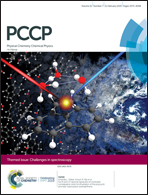Potential dependent capacitance of [EMIM][TFSI], [N1114][TFSI] and [PYR13][TFSI] ionic liquids on glassy carbon†
Abstract
Differential capacitances of ionic liquids (ILs) butyl-trimethylammonium bis(trifluoromethyl sulfonyl)imide, [N1114][TFSI], methyl-propylpyrrolidinium bis(trifluoromethylsulfonyl)imide, [PYR13][TFSI], and ethyl- methylimidazolium bis(trifluoromethylsulfonyl)imide, [EMIM][TFSI], were measured by electrochemical impedance spectroscopy (EIS) over the entire electrochemical window determined by cyclic voltammetry (CV). Distinct fast charging and discharging process frequencies were obtained from the complex capacitance plane extracted from EIS. The onset frequencies of the charging processes were found to be independent of the bulk viscosity of the liquid. [N1114][TFSI] showed the largest relative increase in capacitance with respect to the point of zero charge with applied potential as a result of the ‘crowding’ effect. This is attributed to a larger degree of rotational freedom associated with the independent alkyl chains and the accessibility of larger potentials with the more stable cation. The largest overall capacitance among the ILs studied was observed for [PYR13][TFSI] at its anodic maximum which occurs due to ‘overscreening’. The interpretation of the measured differential capacitance according to the extended mean field theory of Goodwin–Kornyshev [Z. A. Goodwin, et al., Electrochim. Acta., 2017, 225, 190–197] reveals that the ILs with increased ion associations demonstrate the largest relative increase in capacitance with potential.
![Graphical abstract: Potential dependent capacitance of [EMIM][TFSI], [N1114][TFSI] and [PYR13][TFSI] ionic liquids on glassy carbon](/en/Image/Get?imageInfo.ImageType=GA&imageInfo.ImageIdentifier.ManuscriptID=C8CP04631J&imageInfo.ImageIdentifier.Year=2019)


 Please wait while we load your content...
Please wait while we load your content...